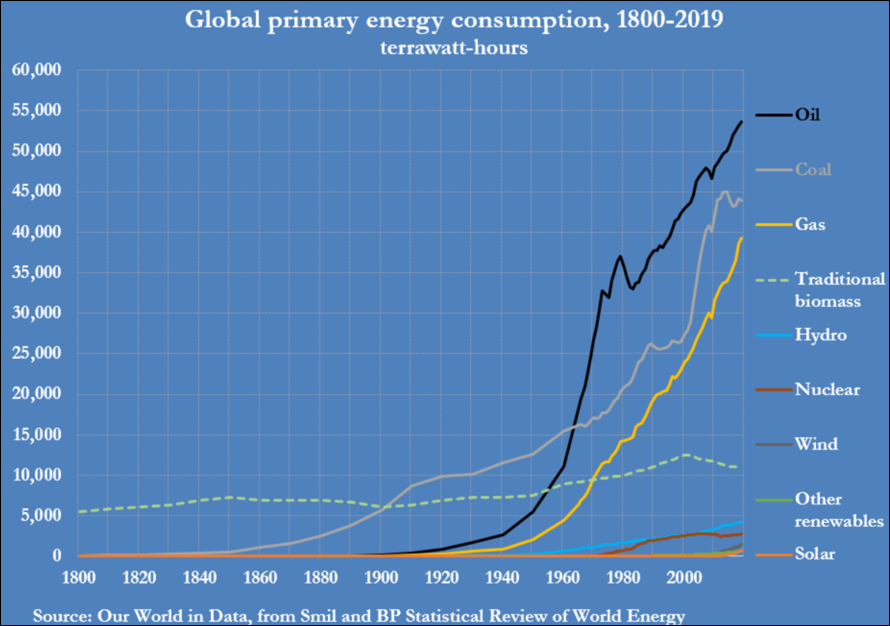the Plug #5 | On Fossil Fuels
Why fossil fuels play a critical role in our energy mix
Welcome to the 15 new subscribers who’ve joined us. If you haven’t yet subscribed, the link below will help solve that problem. 👇
This week, we’re trying to understand why fossil fuels are still so prevalent. Similarly, we discuss what’s needed for renewable energies to become more competitive.
If you know someone that may find this content interesting, please send it their way!
Read time: ~7-8 minutes
The Sun Hasn’t Set on Fossil Fuels 🦖
Oil, coal, and natural gas all get a lot of negative publicity. While, amidst the push for environmental sustainability, renewables including solar and wind have become energy darlings.
But where do we really get our energy from?
Right now, the answer is mostly from fossil fuels.
In 2020, ~87% of the world’s primary energy was generated from three resources: oil (34%), coal (28%), and gas (25%). These figures have increased dramatically over the past 120 years; in 1990, fossil fuels made up only ~47% of primary energy globally.
What about renewable energies? Well, their role is surprisingly immaterial.
Last year, the energy generated from solar, wind and hydro made up only 6-7% of the world’s primary energy. If you exclude hydro, that number falls to 2-3%.
It’s worth noting that there’s also a stark difference in the penetration of renewables between developed and emerging economies.

So why is it that fossil fuels are still the world’s main source of energy?
There are three main factors that drive global decision-making around energy consumption.
Availability: What are my options for how to generate energy? What resources are available in my immediate vicinity ?
Price: How much is this one type of energy going to cost me? Are there cheaper alternatives available?
Reliability: How reliable is this type of energy? Can I count on it being there whenever I need it?
Fossil fuels check all three boxes – they’re plentiful, they’re inexpensive, and they reliably generate energy.
Which explains why these three natural resources generate most of our energy today. Transitioning away from fossil fuels will require two things from renewable energies: cost reductions, and reliability increases.
Renewables will certainly play a large role in the future of global energy.
But the past and the present? They’re dominated by fossil fuels.
Solar’s on Sale ☀️
To harness the sun, the Greek god Apollo needed only a chariot and four horses. It turns out that this depiction undersold the difficulty of capturing the sun’s energy.
To generate enough solar energy to power thousands of homes, or even an entire city, is no easy task. This is, in part, due to solar energy’s lack of power density. The result is that solar energy has historically been prohibitively expensive relative to other options (i.e. fossil fuels).
But a fourth criterion has recently emerged for energy consumption decisions.
By burning fossil fuels to generate our energy, we produce a lot of emissions. And we are slowly waking up to the reality that those emissions are impacting our global climate. In response, the “environmental impact” of our energy has been added to the list of considerations, alongside availability, price and reliability.
This revision has been a tailwind for renewable energy technologies.
An outpouring of support has driven investment, research, and development in the solar energy industry. The dollars and hours spent on innovation have greatly reduced the cost of solar energy.
According to Ramez Naam, the Co-Chair of Energy and Environment at Singularity University, solar energy costs have declined by a factor of between 5 and 8 since 2010. There is some variability in the cost declines across different geographies. But consistently, across the world, solar energy costs are considerably lower today than they were a decade ago.
In fact, solar energy is increasingly becoming cost-competitive with fossil fuel alternatives. And that’s a big deal.

The chart above illustrates the fee that large electricity providers (specifically public utilities) have paid to solar energy suppliers under long-term contracts between 2010 and 2020.
For those electricity providers, diversifying their energy generation mix to include solar energy is slowly becoming a no-brainer as solar’s cost falls.
Admittedly, solar energy’s lack of reliability is still problematic. And like any developing technology, there are also a handful of other challenges.
But declining solar costs are a step in the right direction.
Bigger Wind Turbines 🌬️
Progress has also been made in wind energy technology.
The logic behind wind energy improvement is pretty simple: bigger = better.
Wind energy technology has seen three major developments in recent years:
Developing bigger blades and rotors has increased the energy production potential from a single turbine.
Lifting the turbine’s blades higher into the air, where the wind blows more consistently, increases the reliability of a turbine’s energy production.
Building wind turbines offshore, in the middle of the ocean, alleviates some construction challenges associated with building bigger turbines (although, admittedly, it also creates new problems).
GE capitalized on all three developments with the introduction of the Haliade-X wind turbine.

At a height of ~260 meters, this turbine is only ~61 meters smaller than the Eiffel Tower and ~3 times taller than the Statue of Liberty. And the blades? Each one is longer than a football field.
The increased size of wind turbines, and the ability to access offshore wind resources, have dramatically increased the scale and reliability of wind energy technology.
This too will challenge the role of fossil fuels as the bedrock of our energy system. But don’t be mistaken – as the Black Mamba once said, the job’s not finished yet.
More innovation is critically important for renewable energies to continue gaining ground on fossil fuels.
And finally, to address this West Coast Heat Wave… 🔥
As I sit here in my room, with sweat dripping off my brow, the importance of reducing emissions from our energy consumption feels ever more pressing.
To continue relying on energy generated from fossil fuels is to accept that global weather patterns will become increasingly sporadic.
While the weather here in British Columbia may have set all-time records this week, don’t expect that record to go unbroken for long.

